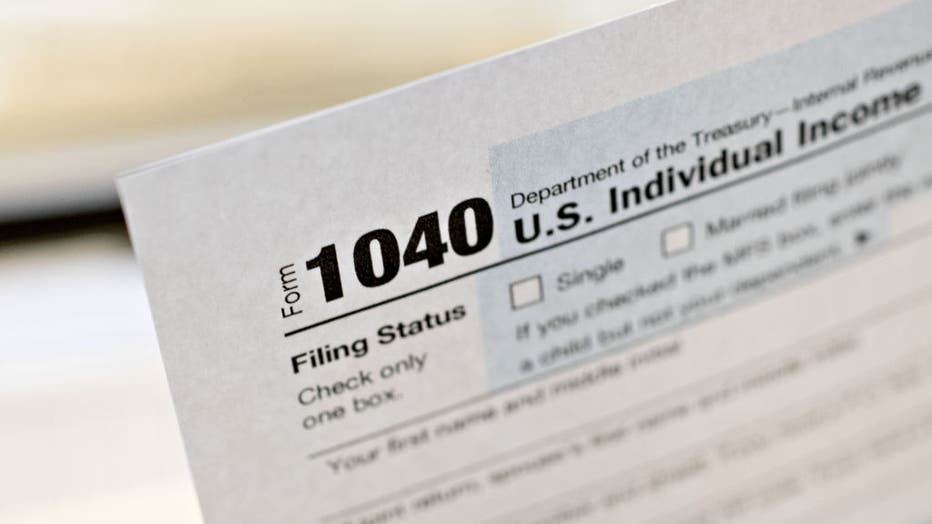Child tax credit 2021 payments: How to know if you owe, IRS letter to watch for
WASHINGTON - Many parents across the U.S. received monthly payments in 2021 as part of the expanded Child Tax Credit program, and with tax season coming up, there is some important information to know and look out for in 2022.
The Internal Revenue Service began sending letters to recipients of the program in late December and into January. The notice, called Letter 6419, includes the total amount of advance CTC payments taxpayers received in 2021.
Furthermore, some parents may end up owing money to the IRS if they received more than they can properly claim on their 2021 taxes, according to the agency.

FILE - A U.S. Department of the Treasury Internal Revenue Service (IRS) 1040 Individual Income Tax form for the 2019 tax year is arranged for a photograph in Tiskilwa, Illinois, on March 20, 2020. Photographer: Daniel Acker/Bloomberg via Getty Images
What is the expanded Child Tax Credit program?
The expanded program boosted the CTC from $2,000 to $3,000 for every child ages 6 to 17, and up to $3,600 for every child under the age of 6, according to the White House. It was passed earlier in 2021 as part of President Joe Biden’s $1.9 trillion COVID-19 relief package and was based on 2019 and 2020 tax returns — intended to help struggling families during the pandemic.
It essentially advanced some tax relief that would normally come the following year when parents file their taxes. Instead, most eligible families started receiving the amount via monthly payments in July of 2021.
Eligibility included people earning $75,000 or less, married couples making $150,000 or less, and a single parent filing as the head of household making up to $112,500.
Studies have suggested that the child tax credit expansions could cut child poverty by 40% — with 9 of 10 American children benefiting, according to an analysis from the Center for Budget and Policy Priorities.
But the program of monthly checks expired at the end of 2021 after Congress failed to pass legislation that would have extended it, tied to Biden’s stalled $2 trillion social and environmental spending bill.
Some recipients of the expanded Child Tax Credit could owe
The IRS notes on its website that the amount of advance CTC payments issued during 2021 was based on the agency’s estimate of what the family would be allowed for the 2021 tax year.
The estimate is based on the 2020 tax return, or if that isn’t available — the 2019 tax return. It’s also based on any updated details that were proactively provided to the IRS in 2021, including updated information through its Child Tax Credit Update Portal.
"Family and life situations can be fluid throughout a given year," the IRS notes.
While there isn’t a special calculator on the IRS’ website to determine if excess monthly CTC payments were made, the agency lists a number of situations that could have resulted in this.
Examples include if the recipient’s income increased in 2021, if their filing status changed in 2021, and if a qualifying child who resided with the recipient changed homes during 2021 and lived more than half of the 2021 tax year with a different individual.
Another reason a recipient could have received excess payments and may owe is if their main home was outside of the U.S. for more than half of 2021, the IRS says.
"If you receive a total amount of advance Child Tax Credit payments that exceed the amount of Child Tax Credit that you can properly claim on your 2021 tax year, you may need to repay to the IRS some or all of that excess payment," the agency says online.
Repayment protection offered by IRS for some
For those who do owe money to the IRS when they file, some may qualify for full repayment protection and won’t need to repay any excess amount. Eligibility for this includes if their main home was in the U.S. for more than half of 2021 and if their modified adjusted gross income (AGI) for 2021 was at or below the following amount, based on the filing status on your 2021 tax return:
-$60,000 if you are married and filing a joint return or if filing as a qualifying widow or widower;
-$50,000 if you are filing as head of household; and
-$40,000 if you are a single filer or are married and filing a separate return.
"If you do not qualify for repayment protection, you will need to report the entire excess amount on your 2021 tax return as additional income tax. This additional income tax will reduce the amount of your tax refund or increase your total tax due for 2021," the IRS says.
What happens if taxpayers owe the IRS for excess CTC payments, but can’t afford it?
Most individuals who owe for excess advance CTC payments will just see a reduction in their expected federal income tax refund, according to the IRS.
However, for those who owe a balance in excess of their refund, the IRS routinely works with taxpayers who owe amounts they can’t afford to pay.
The agency says the process to make a payment arrangement for these balances due is the same as for other tax balances. Click here for information on applying for payments plans and more.
This story was reported from Cincinnati.

